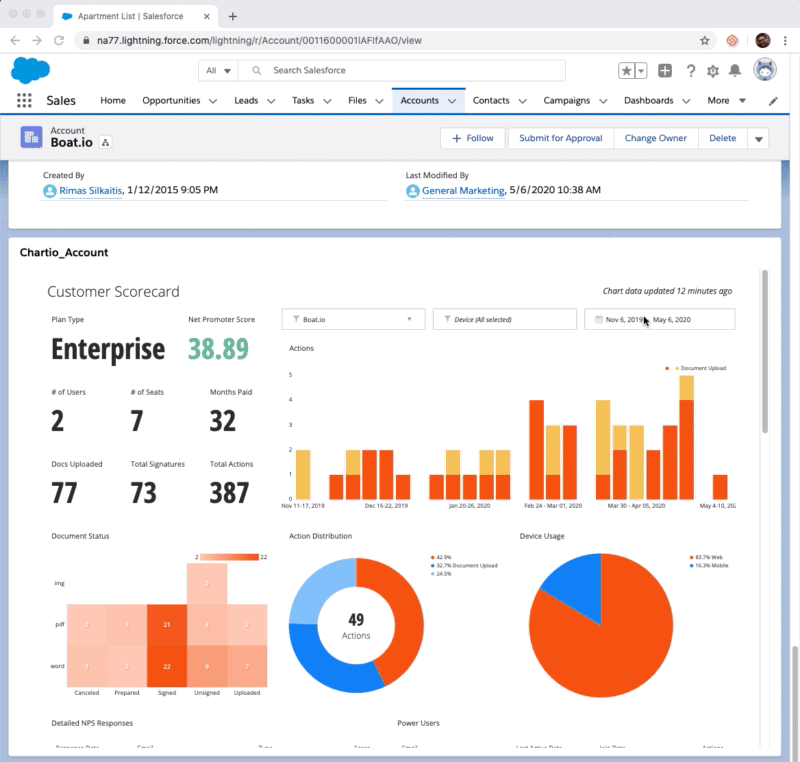Show Your Value with Embedded Analytics: 4 Top Use Cases for Embedding
Posted by on October 26, 2020 Chartio

With a growing demand to place data in products, portals and various applications, we see many customers looking for an embedded analytics solution. But should you look for another product if you already have a BI solution that works for your team? The answer is ‘no.’ With a good BI product, you should not be doing, nor paying for your data twice.
To help our customers understand how this works, I took the webinar stage with my colleague Emilie Crangle, Data Advisor at Chartio. Here’s a quick digest that will help you and your team better understand the benefits of doing embedding within your BI tool.
Let’s start with the use cases. As discussed on our webinar, we’ve identified four top use cases for embedded analytics.
1. Integrated reporting in pre-existing workflows through most used applications
One of the key benefits of embedded analytics is its ability to integrate reporting into pre-existing workflows. The average company has 40+ SaaS technologies in their tech stack. With so many applications, teams find it challenging to garner the insights they need in the workflows they repeat often. By embedding the dashboards into the most used applications like Salesforce or Confluence, teams can easily pull insights from multiple data sources in one place.
Customer Example: Context switching is not only tough, it’s exhausting. Teams with lower churn use technology to effectively do their jobs but when your teams are forced to bounce between tools and reports that are scattered in a variety of workflows, inefficiencies arise and frustrations mount. This was the case for one of our customers. Every time a new technology was introduced, their workflows became more disrupted and making decisions based on data became less of a priority. It was too hard to try and get insights when the data lived in multiple systems, spanning a variety of reports. Embedded analytics allowed them to place necessary reports in the applications they frequented most – delivering them insights to work better, smarter and faster. No more context switching. No more wasted time. Data now lives within pre-existing workflows and can be accessed at any time.
2. Share your team’s performance
A common thread that every successful company shares is transparency. In today’s economy, honesty and an open-book-brand is what customers, partners and investors want. In order to lead with transparency, you cannot have your data siloed. Every member of your team must have visibility into key performance metrics. These charts must be up to date, accurate, and accessible.
Companies without embedded analytics often try bandaid solutions such as sharing screenshots that prove ineffective as they are most likely to be out of date and get lost in countless emails or Slack messages. With embedded analytics, dashboards can be shared on any internal pages, allowing everyone on your team to review and leverage to make informed decisions, fast.
Customer Example: We’ve seen many of our customers embed dashboards on monitors, or on all-hands Zoom calls to surface important KPIs for visibility across different teams. Data is most effective when surfaced and shared and it’s easier to encourage accountability and momentum for employees to hit their goals when the data is easily visible.
3. Transparency with external vendors, partners, and customers
As mentioned above, companies who are transparent with their data are trusted companies. By surfacing the metrics that best represent company and customer health, you immediately gain respect and differentiation. Embedded analytics is the vehicle to achieve this. Without it, your teams would spend hours, if not days, every week trying to update reports manually with the risk that a report could be incorrect or outdated.
Instead of manually pulling the numbers or taking screenshots of the dashboards every time you get a request, you can simply embed the dashboards in portals for them to access at their convenience.
Customer Example: Chartio works with a non-profit organization who is leveraging Chartio’s embedding feature on their public website to share information on their growing number of customers, reach and goals. This allows the organization to be transparent about their numbers and progress with anyone who’s interested.
4. Embed customer data in your product
Companies see huge value in embedding customer data in their products to monitor information like product usage.
We’ve seen so many use cases for this – from customers in the retail space embedding dashboards into their customer portals to gain insight into how brands/markets/teams are performing, to product and sales teams utilizing it to demonstrate the value of their products to their customers.
Revenue teams can leverage such data to support informed conversations with their prospects or customers. With customer data easily accessible, teams can quickly understand where their product hang ups are and proactively prepare for them, instead of having to be on a reactive, defensive mode every time an issue is brought up.
Customer Example: Chartio (👋 Hey, that’s us!) practice what we preach! We’ve embedded analytics in multiple places on our application so that our customers can easily check their usage stats or data source performance stats whenever they need without having to rely on our CS team to manually check and send a report. This saves a lot of time for our CS team and eliminated frustration for our customers.
How to Get Started with Embedded Analytics
Chartio customers have seen huge value in our embedding solution for years, but we wanted a quicker and easier way for our customers to dig into their data from the embedded dashboards. So, we’ve released Interactive Embedding, an updated version of our already-popular feature that is more powerful and performant.
Companies should use embedded analytics as a feature of a larger BI platform to achieve visibility, transparency, and increased efficiency across all teams. There are an abundance of embedding solutions out in the market, so I suggest you explore and look into different features of each to figure out what solution might be the best fit for your company.
If you are ready to try our Interactive Embedding, you can sign up for a demo with our team here. If you are still exploring and looking for more details, I highly encourage you to check out our on-demand webinar Show Your Value with Embedded Analytics and reach out to us with any questions you may have.


